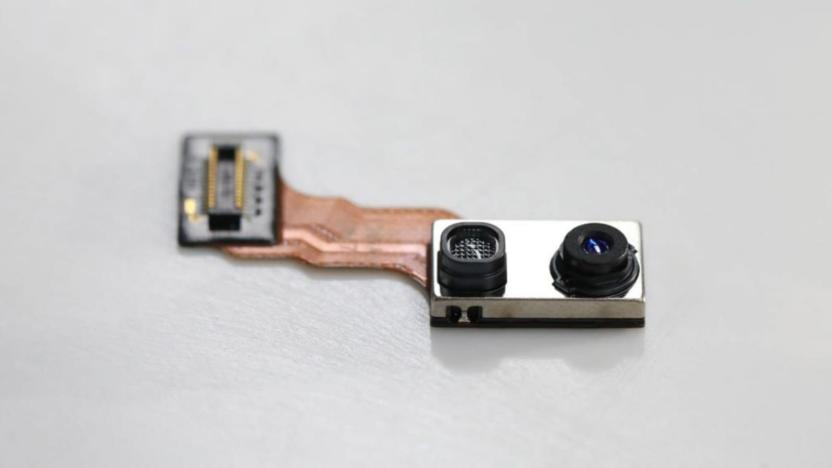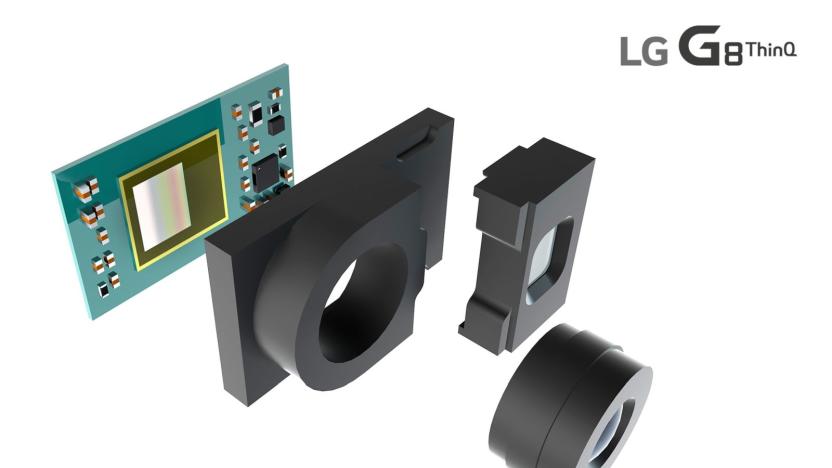TimeOfFlight
Latest

LG explains how the G8 ThinQ's tiny gesture sensor works
LG has revealed more details about the "Time of Flight" sensor that will likely power the G8 ThinQ's touchless gestures. Built by LG's Innotek division, it reflects infrared light off of a subject, measures how long it takes to return and uses the data to calculate depth. LG said that the tech works over "long" distances, while consuming less power than other 3D tech. As such, it's suitable for face detection ID tech, motion sensing, AR, and more.

LG's G8 will fight Face ID with its own 3D front-facing camera
LG isn't ready to show off all of the details around its next flagship phone just yet, but tonight it has revealed the technology we'll see in the G8 ThinQ's front-facing camera. By including a "Time of Flight" image sensor made by Infineon, LG claims it can deliver features like facial recognition, augmented reality and better selfies in all kinds of lighting conditions while using less power than other solutions like Apple's Face ID. While Apple's TrueDepth technology for Face ID is similar to what we saw in the Xbox 360 Kinect where it projects thousands of laser dots then measures the distortion to figure out where things are, Time of Flight is the tech Microsoft hoped it would get better results from for the Xbox One Kinect device. By capturing IR light as it reflects off of a subject, the idea is that it will give more accurate results with less computing power. There have been rumors that Apple is considering implementing it in the iPhone's rear-facing camera, however well-sourced analyst Ming-Chi Kuo shot those down, saying the device's existing dual-camera setup would suffice.

Vivo's all-screen NEX goes dual-display to ditch the pop-up camera
While Vivo is still a largely exotic brand for many of us, you may remember it as the first manufacturer to both tease and release a truly bezel-less smartphone. And of course, Vivo's NEX S gained extra street cred thanks to its pop-up selfie camera plus in-display fingerprint reader. Just months later, the Chinese company is back with a follow-up model dubbed NEX Dual Display Edition, and as the name implies, it packs a screen on both sides of the phone, just so that it can ditch the pop-up camera -- a cool but physically vulnerable feature -- while still avoiding the notch on the main screen.

Apple’s 2019 iPhone could have a rear-facing 3D sensor
Apple has made no secret of its interest in augmented reality (AR) -- in interviews CEO Tim Cook gives it as much attention as sales growth. Now, it's rumoured that the company's 2019 iPhone release will come with a rear-facing 3D sensor, potentially turning the model into a leading AR device.

WiFi distance detector could shut out router invaders
Researchers from MIT have figured out how to detect the distance between WiFi users and a single router, a feat that could make drones safer and public internet more secure. They did it by measuring the "time of flight" of WiFi signals between the transmitter and receiver, and multiplying by the speed of light to calculate distance. That concept isn't new, but MIT's CSAIL team, which has already looked through walls using WiFi, managed to build a working prototype.

Sony buys a company that makes Kinect-like depth sensors
Sony has purchased SoftKinetic, a Belgian startup that's most famous for creating image sensors that can digitally capture objects in 3D. The firm specializes in time of flight, a camera technology that you'll be familiar with if you've ever used the Xbox's Kinect camera. If you've got long memory, you'll recall that SoftKinetic provided the necessary technology to make Just Dance work on the PlayStation, as well as 3D scanners for MakerBot. Now, it's going to become a wholly-owned subsidiary of the Japanese conglomerate, giving the firm a useful knowledge boost in an area that's growing increasingly important. After all, since Sony is developing PlayStation VR, smart glasses and produces the camera sensors for much of the mobile industry, that know-how is likely to be in plenty of products in the not-too-distant future.

PMD and Infineon to enable tiny integrated 3D depth cameras (hands-on)
After checking out SoftKinetic's embedded 3D depth camera earlier this week, our attention was brought to a similar offering coming from Germany's PMD Technologies and Infineon. In fact, we were lucky enough to be the first publication to check out their CamBoard Pico S, a smaller version of their CamBoard Pico 3D depth camera that was announced in March. Both reference designs are already available in low quantities for manufacturers and middleware developers to tinker with over USB 2.0, so the two companies had some samples up and running at their demo room just outside Computex. %Gallery-190502%

SoftKinetic teases embedded 3D depth camera, coming to Intel devices next year (hands-on)
At Intel's Computex keynote earlier today, the chip maker teased that it expects embedded 3D depth cameras to arrive on devices in the second half of 2014. Luckily, we got an exclusive early taste of the technology shortly after the event, courtesy of SoftKinetic. This Belgian company not only licenses its close-range gesture tracking middleware to Intel, but it also manufactures time-of-flight 3D depth cameras -- including Creative's upcoming Senz3D -- in partnership with South Korea-based Namuga. Read on to see how we coped with this futuristic piece of kit, plus we have a video ready for your amusement. %Gallery-190272%

Hands-on redux: Creative's Interactive Gesture Camera at IDF 2013 Beijing (video)
At IDF 2013 in Beijing, Intel is again making a big push for perceptual computing by way of voice recognition, gesture control, face recognition and more, and to complement its free SDK for these functions, Intel's been offering developers a Creative Interactive Gesture Camera for $149 on its website since November. For those who missed it last time, this time-of-flight depth camera is very much just a smaller cousin of Microsoft's Kinect sensor, but with the main difference being this one is designed for a closer proximity and can therefore also pick up the movement of each finger. We had a go on Creative's camera with some fun demos -- including a quick level of gesture-based Portal 2 made with Intel's SDK -- and found it to be surprisingly sensitive, but we have a feeling that it would've been more fun if the camera was paired up with a larger display. Intel said Creative will be commercially launching this kit at some point in the second half of this year, and eventually the same technology may even be embedded in monitors or laptops (remember Toshiba's laptops with Cell-based gesture control?). Until then, you can entertain yourselves with our new hands-on video after the break. %Gallery-185293%




